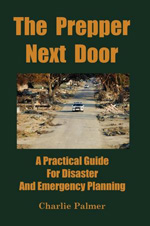For those who’ve read my book, you know I focus on providing the basics for most common disasters. You don’t need to know what disaster or emergency you face to know that storing water and food is a good idea. Anything that can isolate you for a week or two from grocery stores is covered if you have a two-week supply of food. It doesn’t matter if it’s a hurricane, flood, civil unrest, or icy roads. You stay home. You eat.
If you have a two-week supply of water, if anything disables your plumbing supply pipes to your house, you have water to drink. It doesn’t matter if it’s an earthquake or flood that disables your supply pipes. The basics are valuable in many scenarios.
As a life-long “prepper” I’ve seen other survivalists prepare for everything from economic collapse to nuclear war to EMP to runaway viruses. Each of us must ask ourselves: Just how far should we take our preps? How much specialty preparation is “too much”?
Let’s look at some of the absolute basics that are too often overlooked:
1) Your physical health. This is crucial to survival in many situations. If you need to flee a burning building, escape rubble in an earthquake, or just minimize the chances you have a heart attack or get diabetes, you must make your physical health your number one priority.
As we age, we lose physical capability. This is a sad fact. Each of us should be realistic but still aim to be in the best physical shape we can be in. If you’re in your twenties and exceptionally fit, go ahead and try out for American Ninja Warrior. If you’re in your late sixties, go for a daily walk. Choose a level of exercise that fits where you’re at in your life.
Regardless of age, try to eat healthy. Fruits, vegetables, and whole grains are your friend. Get regular check ups so you catch medical issues early.
2) Your financial health. I don’t know why, but some preppers hate to hear this: Your ability to successfully recover from “economic collapse” is directly proportional to your wealth. Sure, owning a Glock 19 and being able to defend yourself from a breakdown of law and order is good. Having a year supply of food is great. Investing in gold or foreign currencies can’t hurt. But from the recent economic downturn in America, to the Great Depression, to the economic problems in Greece to the economic meltdowns in Argentina and Russia, more wealth is better.
The more you have saved, the larger your earnings, and the more stable your earnings, the better off you are. Money is the highest predictor of how well a family will be able to recover from most disasters.
The super rich can afford financial losses. It’s just a number on a paper. The Middle Class can’t afford to lose income or it adversely affects their life. Unlike squirreling away guns and Geiger counters, saving money isn’t sexy.
Find a career you love and which can earn you a good living. Live below your means and build a nest egg for emergencies.
3) Your social connections. This is a topic that’s getting more attention in the prepper community. Demcad has several videos that talk about the importance of building relationships. In his book Prepper’s Home Defense, Jim Cobb writes about “Lone Wolf Syndrome.”
Many preppers are loners by nature. We like to figure things out for ourselves. We like to be self sufficient. The reality is that few of us can survive without the help of others. We need to draw on the knowledge and experience of others. We need help from time to time. It could be help lifting sheet rock to finish a basement or help guarding our neighborhood in a riot.
The more diverse your connections the better. Social connections can partly offset number 2) your financial health. If your home is destroyed in a flood or fire, where will you go? If you have family or friends that will put you up, you’ll save a ton of money compared to staying in a hotel.
To have people you can rely on, you need to be reliable yourself. Said another way, to have good friends, you need to be a good friend. Of course, in society there are some people who don’t reciprocate. They want others to help them, but they never want to help others. You don’t need people like that in your network of friends and family.
A recent study said married people have a better chance of surviving cancer than single people. It makes sense. If you’re run down, do you have somebody who forces you to go to the hospital? If you have nobody at home to feed the dog, you level of stress skyrockets.
A reality prepper should focus on the basics before engaging in prepping for highly unlikely events like a nuclear war. Sure, if you have the time and money, put aside a complete high-end hazmat suit to protect you from biological viruses. First, though, shore up your physical health, your financial health, and your social connections. Everything builds from there.
Charlie Palmer -author The Prepper Next Door: A Practical Guide For Disaster And Emergency Planning
